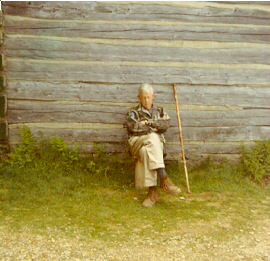| LeConte Lodge Alumni Site |
Rev. A. Rufus Morgan:
"Moses of the Mountains"
Anyone who spends much time in the Southern Appalachians soon hears the name A. Rufus Morgan, or, Rufus Morgan. Rufus lived from 1885-1983; he was an Episcopal priest. Rufus Morgan was born in Franklin, N.C. and always considered the Smoky Mountains his home. He completed high school in Waynesville, N.C.; graduated from the University of North Carolina; and received his theological education at General Theological Seminary in New York City, and Columbia University. His ministry included St. Peter's in New York City, Penland School of Handicrafts, Penland, North Carolina; several small churches in South Carolina; and, 11 small churches in western North Carolina.
Rufus helped build St. Francis of Assisi Episcopal Church in Cherokee, NC. The church has a website that includes a biography of Rufus -- who was known as "Moses of the Mountains."
Rufus loved the Appalachian Mountains of North Carolina and Tennessee. He was a regular visitor to LeConte Lodge -- I recall meeting him several times and my brother, John, took this photo of Rufus in 1969.

Places named for Rufus
Rufus not only loved the mountains, he also was active in several hiking clubs and was instrumental in helping establish the Appalachian Trail in the Southern Appalachians. To honor his contributions to the mountains, his name has been attached to several places Western North Carolina.
- Hikers on the Appalachian Trail can stay in the A. Rufus Morgan shelter in the Nantahala National Forest, Swain County, NC.
- Near Franklin, NC, you will find the Rufus Morgan Falls. Here is another link to Rufus Morgan Falls.
- Here is a link and description of Rufus Morgan Trail in Macon County, NC.
- This website belongs to "Chelle Rose," a local singer and songwriter from Loudon County, Tennessee. She wrote a song inspired by Rufus. Note in her description of the song that she mentions a PBS documentary about Rufus hiking up LeConte at age 92 -- as of March 2006 I am trying to track down that documentary.
Rufus and Lucy Morgan and The Penland School of Crafts
Penland School of Crafts is a national center for craft education located in the Blue Ridge Mountains of North Carolina. Penland was founded by Miss Lucy Morgan, who came to Penland in 1920 to work as a teacher at the Appalachian Industrial School, an Episcopal mission school established primarily by her brother Rufus. What she found was an opportunity to expand that school’s vocational program to include handicrafts, particularly weaving.
At that time very few women in the community still practiced the craft. Morgan realized that the reintroduction of weaving would not only revive a local tradition, but could also provide economic support for families. She invited well-known weaving expert Edward Worst to teach annual workshops and in 1929, when requests for craft instruction began to come from other parts of the country, Penland School was born.
Today, Penland School of Crafts is a national center for craft education with programs in fourteen professional studios that encompass traditional and contemporary craft, providing instruction in books and paper, clay, drawing and painting, glass, iron, metals, photography, printmaking, textiles, and wood.
Penland School celebrated their 75th anniversary in 2004; this retrospective gives the history of the school. Note the prominent part played by Rufus and his sister Lucy.
More links about Rufus Morgan
Here are more links I found on the Internet that mention Rufus Morgan and that reveal the extent of his influence on the lives of people in the Southern Appalachians.
- The Episcopal Church and the Visual Arts.
http://www.ecva.org/newsletter/2004/july/ecva_newsletter_july.htm - Excellent article on the Penland School with a lot of background
on Lucy Morgan and mentions of Rufus.
http://www.mountainx.com/ae/2004/0317penland.php
To be continued -- with your help
This article was started on 29 march 2006. If you have more photos or stories of Rev. Rufus Morgan, or if you can point me to such information, please send an e-mail message.
NOTE: If you do a Google search for "Rufus Morgan," you will find several entries about another Rufus Morgan who was a noted photographer in North Carolina who lived 1846 - 1880 -- he is not our Rufus Morgan but his story is interesting. Here are some links about him:
- A brief biography: http://dd1.library.appstate.edu/regional_history/photographers/morgan.htm
- An inventory of the Rufus Morgan Collection in the library at the
University of North Carolina:
http://www.lib.unc.edu/ncc/pcoll/57morgan/
LeConte Lodge Site Table of Contents
| Photo album |
| Brief history of LeConte Lodge |
| Joe's LeConte stories |
| Reverend A. Rufus Morgan |
| Gracie McNicol: 244 times up LeConte |
| Links to other sites |
| LeConte Lodge in winter |
|
LeConte Llama Wrangler Retires After Ten Years
(Nov 2011) |
| Suggested reading |
| How to submit your articles for publication. |